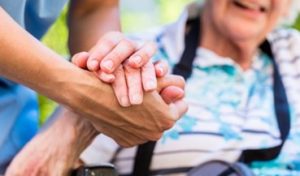Hospice Nurse: Top Things People Get Wrong About Death
 Dying is an inevitable part of life. Although it happens to everyone, death is not talked about very often. It remains a taboo topic for many people, surrounded by fear and uncertainty. The way death is portrayed in movies or television isn’t always accurate, either.
Dying is an inevitable part of life. Although it happens to everyone, death is not talked about very often. It remains a taboo topic for many people, surrounded by fear and uncertainty. The way death is portrayed in movies or television isn’t always accurate, either.
As a result, there are many widespread misconceptions about death and people who are dying, Hadley Vlahos, a registered hospice nurse living in the New Orleans area, tells TODAY.com. Vlahos breaks down some of these myths and recounts the realities of death in her new book, “The In-Between: Unforgettable Encounters During Life’s Final Moments,” out Tuesday, June 13.
Even though we tend to avoid discussions about death, most people are often curious and have questions, says Vlahos. “I certainly don’t have all of the answers, even though I’ve seen death enough times that I have a general idea of what to expect,” she writes.
What are some common misconceptions about the dying process, hospice, and death?
MYTH: Death happens all at once
While sudden and unexpected deaths do occur, dying (especially at older ages) is often more slow and gradual than people realize, Vlahos explains. “The vast majority of people will die of a terminal illness, not an accident,” says Vlahos.
A terminal illness or end-stage disease is one that’s incurable and will inevitably result in death — examples commonly seen in hospice patients are cancers, cardiac diseases, Alzheimer’s, and chronic obstructive pulmonary disease, says Vlahos.
Some patients may decline quickly, but in most cases dying is more of a process than an event, Vlahos explains. That process can start much earlier than people realize. “Our bodies will gradually start to shut down. … A couple of months beforehand, we start to see people eating a little bit less or sleeping more … and just getting a bit more tired from everyday activities, basically.”
In the final days before death, Vlahos says people are often sleeping the majority of the time and may stop eating or drinking. They may go into a “semi-comatose state,” she explains, before they stop breathing.
“Our bodies naturally know how to (shut down). … It’s like how our bodies know how to go into childbirth; our bodies know how to die and they will naturally do that,” says Vlahos.
MYTH: Dying is always painful
Pain does not have to be part of the dying process, Vlahos notes. However, the diseases or conditions that precede a person’s death can cause painful symptoms. Fortunately, these can usually be managed.
The goal of hospice is to make the dying process as comfortable and pain-free as possible, says Vlahos. This can involve pain medication, supportive care like oxygen and fluids, and mental health or social support. In many cases, Vlahos says she sees patients become very calm and peaceful in the hours before death.
“It’s ultimately up to the patient and their family, but we don’t have as many restrictions on giving pain medication so we can make patients comfortable,” says Vlahos, adding that the goal is to help patients relax and improve their quality of life as it ends.
However, Vlahos warns about the myth that hospice care involves giving lethal doses of pain medication, which is false. “We do not give that high of an amount, and there’s a big difference between what can take away pain and what is enough to kill someone,” she says.
MYTH: Death is a medical event or failure
“The reality is it’s impossible to avoid death,” says Vlahos. Despite this, death is still perceived by many as a failure of the medical system or a medical event rather than a natural one, even if an illness is terminal.
“If it’s going to happen, no one can escape it,” she adds.
Vlahos says she often sees this in the language people use around terminal illnesses — “when people are like, ‘I’m praying for a miracle,’ or, ‘Don’t stop fighting,’ … that’s not very helpful to many people,” says Vlahos.
She says that patients and their families will often tell her that phrases like these are actually “very demotivating” because they make them feel like they’re giving up or doing something wrong by accepting the possibility of death.
“In my opinion, getting a patient to (die) on their own terms is how it should be. … You’re taking back your life in my opinion,” says Vlahos.
MYTH: Hospice is only for people who are about to die
“A lot of people think hospice is just for people who have one week or a couple of days left to live, and that’s not the truth,” says Vlahos. “We can take people who clinically have six months or less to live as determined by a doctor … but it’s not an exact science,” she adds.
Even if people have longer than six months to live, says Vlahos, hospice can help make them more comfortable and allow them to make decisions about end-of-life care. “We can get to know them so that, whenever it is time (to die), we know their wishes and can make sure they have the most peaceful death,” says Vlahos, adding that she has even seen hospice patients live for over a year.
“People think, once you’re in hospice, you can never get out of it, but you can come on to hospice then change your mind and come off and come back on again,” says Vlahos. “It’s not jail.”
Hospice patients can live on their own terms, says Vlahos, which may include enjoying their favorite activities, foods and drinks (or even the occasional alcoholic drink, if it’s safe to do so).
Hospice care does not have to occur at a hospital or a facility either. “It’s not necessarily a place or site. Hospice is a service that comes to where you are,” says Vlahos. This could be at a hospital or nursing home but also a patient’s home or a loved one’s house.
MYTH: Hospice speeds up the dying process
Another common misconception is that hospice hastens the dying process. There is no evidence that hospice care speeds up death, says Vlahos, adding that she often sees terminally ill patients live longer than initially projected after they move into hospice care. “Studies have shown that people can live up to 20 days longer on hospice when you look at the differences between patients with the same diseases,” she adds.
Underlying this myth is another misconception, says Vlahos, which is that choosing hospice care is giving up. “In reality, it’s just another type of treatment. … We don’t give up on people. We’re still providing care. We’re just focusing on comfort instead of curing,” says Vlahos. Hospice care still involves some procedures like catheter insertion or wound care, she explains.
“A lot of people who have a terminal illness and have been in a hospital for a long time feel like they’ve given up control … but hospice is taking it back into your own hands as I see it, and I think there’s a lot of power and beauty in that,” says Vlahos.
MTYH: Dying people see a light at the end of tunnel
Fact: The most common vision before death isn’t a light at the end of the tunnel
What a person sees, hears and feels in the moments before death can vary widely. According to Vlahos, it’s common for people to experience end-of-life visions or hallucinations in the final days or hours. However, the majority of these are not the stereotypical “light at the end of the tunnel,” she says — instead, they are often visions of deceased loved ones, especially parents or spouses.
“It’s a very common, unexplainable medical phenomenon that we see, as well as the surge of energy (before death),” says Vlahos, adding that visions of deceased loved can occur in all patients, regardless of religious or spiritual background.
Dying patients may interact with their deceased loved one as if they are in the room, says Vlahos, while simultaneously interacting with living people in that same room. “I often feel like I’m with people when they’re between worlds,” she notes.
Often, people will describe their deceased loved ones coming to get them to go on a trip or journey together before death, Vlahos adds. “It’s a certain peace that really can’t even be explained in words.”
This article was originally published on TODAY.com
(This story originally appeared on Today.com.)




